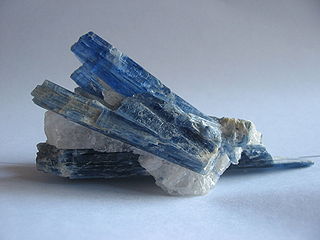
Kyanite is a typically blue aluminosilicate mineral, found in aluminium-rich metamorphic pegmatites and sedimentary rock. It is the high pressure polymorph of andalusite and sillimanite, and the presence of kyanite in metamorphic rocks generally indicates metamorphism deep in the Earth's crust. Kyanite is also known as disthene or cyanite.

In geology and mineralogy, a mineral or mineral species is, broadly speaking, a solid substance with a fairly well-defined chemical composition and a specific crystal structure that occurs naturally in pure form.
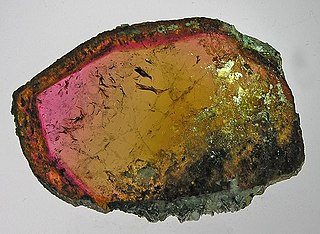
Tourmaline is a crystalline silicate mineral group in which boron is compounded with elements such as aluminium, iron, magnesium, sodium, lithium, or potassium. This gemstone comes in a wide variety of colors.
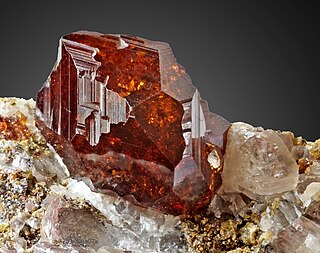
Garnets are a group of silicate minerals that have been used since the Bronze Age as gemstones and abrasives.
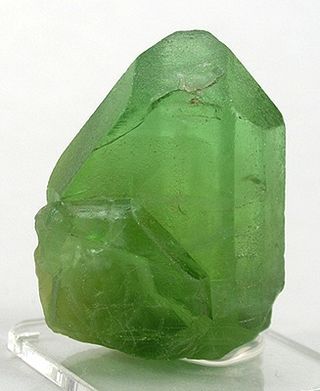
The mineral olivine is a magnesium iron silicate with the chemical formula (Mg,Fe)2SiO4. It is a type of nesosilicate or orthosilicate. The primary component of the Earth's upper mantle, it is a common mineral in Earth's subsurface, but weathers quickly on the surface. Olivine has many uses, such as the gemstone peridot, as well as industrial applications like metalworking processes.

Amphibole is a group of inosilicate minerals, forming prism or needlelike crystals, composed of double chain SiO
4 tetrahedra, linked at the vertices and generally containing ions of iron and/or magnesium in their structures. Its IMA symbol is Amp. Amphiboles can be green, black, colorless, white, yellow, blue, or brown. The International Mineralogical Association currently classifies amphiboles as a mineral supergroup, within which are two groups and several subgroups.

The pyroxenes are a group of important rock-forming inosilicate minerals found in many igneous and metamorphic rocks. Pyroxenes have the general formula XY(Si,Al)2O6, where X represents calcium (Ca), sodium (Na), iron or magnesium (Mg) and more rarely zinc, manganese or lithium, and Y represents ions of smaller size, such as chromium (Cr), aluminium (Al), magnesium (Mg), cobalt (Co), manganese (Mn), scandium (Sc), titanium (Ti), vanadium (V) or even iron. Although aluminium substitutes extensively for silicon in silicates such as feldspars and amphiboles, the substitution occurs only to a limited extent in most pyroxenes. They share a common structure consisting of single chains of silica tetrahedra. Pyroxenes that crystallize in the monoclinic system are known as clinopyroxenes and those that crystallize in the orthorhombic system are known as orthopyroxenes.

Actinolite is an amphibole silicate mineral with the chemical formula Ca2(Mg4.5–2.5Fe2+0.5–2.5)Si8O22(OH)2.

Sekaninaite ((Fe+2,Mg)2Al4Si5O18) is a silicate mineral, the iron-rich analogue of cordierite.

Forsterite (Mg2SiO4; commonly abbreviated as Fo; also known as white olivine) is the magnesium-rich end-member of the olivine solid solution series. It is isomorphous with the iron-rich end-member, fayalite. Forsterite crystallizes in the orthorhombic system (space group Pbnm) with cell parameters a 4.75 Å (0.475 nm), b 10.20 Å (1.020 nm) and c 5.98 Å (0.598 nm).

Silicate minerals are rock-forming minerals made up of silicate groups. They are the largest and most important class of minerals and make up approximately 90 percent of Earth's crust.
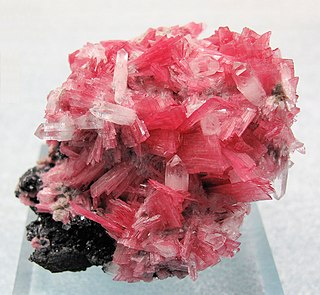
Rhodonite is a manganese inosilicate, with the formula (Mn, Fe, Mg, Ca)SiO3, and member of the pyroxenoid group of minerals, crystallizing in the triclinic system. It commonly occurs as cleavable to compact masses with a rose-red color (its name comes from Ancient Greek ῥόδον (rhódon) 'rose'), often tending to brown due to surface oxidation. The rose-red hue is caused by the manganese cation (Mn2+).
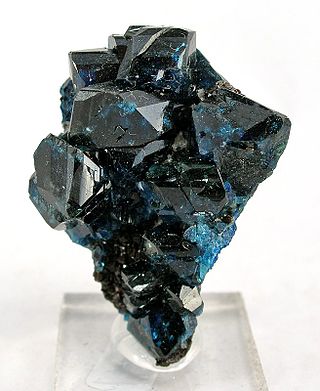
Lazulite or Azure spar is a transparent to semi-opaque, blue mineral that is a phosphate of magnesium, iron, and aluminium, with the chemical formula (Mg,Fe2+)Al2(PO4)2(OH)2. Lazulite forms one endmember of a solid solution series with the darker, iron-rich scorzalite.

Zanazziite is a complex hydrated phosphate mineral from the roscherite group. It is a magnesium beryllium phosphate mineral. Zanazziite arises as barrel-shaped crystals and can reach up to 4 mm. It grows alongside quartz minerals. It is found in the crevices of Lavra da Ilha pegmatite, near Taquaral, in northeastern Minas Gerais, Brazil. Zanazziite is named after Pier F. Zanazzi. Zanazziite has an ideal chemical formula of Ca2Mg5Be4(PO4)6(OH)4·6H2O.
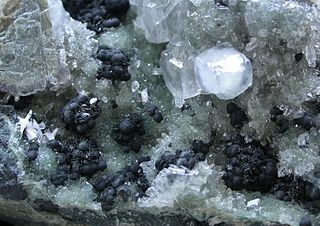
Julgoldite is a member of the pumpellyite mineral series, a series of minerals characterized by the chemical bonding of silica tetrahedra with alkali and transition metal cations. Julgoldites, along with more common minerals like epidote and vesuvianite, belong to the subclass of sorosilicates, the rock-forming minerals that contain SiO4 tetrahedra that share a common oxygen to form Si2O7 ions with a charge of 6− (Deer et al., 1996). Julgoldite has been recognized for its importance in low grade metamorphism, forming under shear stress accompanied by relatively low temperatures (Coombs, 1953). Julgoldite was named in honor of Professor Julian Royce Goldsmith (1918–1999) of the University of Chicago.

Magnesiohastingsite is a calcium-containing amphibole and a member of the hornblende group. It is an inosilicate (chain silicate) with the formula NaCa2(Mg4Fe3+)(Si6Al2)O22(OH)2 and molar mass 864.69 g. In synthetic magnesiohastingsite it appears that iron occurs both as ferrous iron Fe2+ and as ferric iron Fe3+, but the ideal formula features only ferric iron. It was named in 1928 by Marland P. Billings. The name is for its relationship to hastingsite and its magnesium content. Hastingsite was named for the locality in Dungannon Township, Hastings County, Ontario, Canada.

Ferrogedrite is an amphibole mineral with the complex chemical formula of ☐Fe2+2(Fe2+3Al2)(Si6Al2)O22(OH)2. It is sodium and calcium poor, making it part of the magnesium-iron-manganese-lithium amphibole subgroup. Defined as less than 1.00 apfu (atoms per formula unit) of Na + Ca and consisting of greater than 1.00 apfu of (Mg, Fe2+, Mn2+, Li) separating it from the calcic-sodic amphiboles. It is related to anthophyllite amphibole and gedrite through coupled substitution of (Al, Fe3+) for (Mg, Fe2+, Mn) and Al for Si. and determined by the content of silicon in the standard cell.
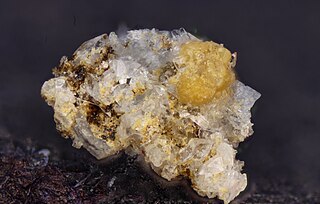
Zigrasite is a phosphate mineral with the chemical formula of MgZr(PO4)2(H2O)4. Zigrasite was discovered and is only known to occur in the Dunton Quarry at Oxford County, Maine. Zigrasite was specifically found in the giant 1972 gem tourmaline-bearing pocket at the Dunton Quarry. Zigrasite is named after James Zigras who originally discovered and brought the mineral to attention.

Antigorite is a lamellated, monoclinic mineral in the phyllosilicate serpentine subgroup with the ideal chemical formula of (Mg,Fe2+)3Si2O5(OH)4. It is the high-pressure polymorph of serpentine and is commonly found in metamorphosed serpentinites. Antigorite, and its serpentine polymorphs, play an important role in subduction zone dynamics due to their relative weakness and high weight percent of water (up to 13 weight % H2O). It is named after its type locality, the Geisspfad serpentinite, Valle Antigorio in the border region of Italy/Switzerland and is commonly used as a gemstone in jewelry and carvings.
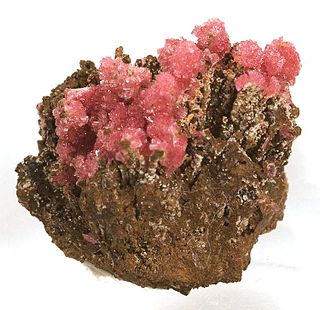
Miguelromeroite is a mineral named for Miguel Romero Sanchez by Anthony Robert Kampf. The mineral, first described in 2008 was named in 2009, the same year it got approved by the International Mineralogical Association.




















